Mt. Fuji World Heritage Centre, Shizuoka
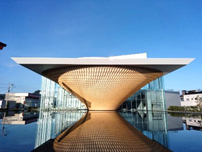 Mt. Fuji was listed as a UNESCO World Cultural Heritage Site, called “Fujisan: Sacred Place and Source of Artistic Inspiration,” in 2013. The Mt. Fuji World Heritage Centre, Shizuoka opened on December 23, 2017, in the city of Fujinomiya in Shizuoka Prefecture with the aim of preserving the story of this world cultural heritage for posterity.
Mt. Fuji was listed as a UNESCO World Cultural Heritage Site, called “Fujisan: Sacred Place and Source of Artistic Inspiration,” in 2013. The Mt. Fuji World Heritage Centre, Shizuoka opened on December 23, 2017, in the city of Fujinomiya in Shizuoka Prefecture with the aim of preserving the story of this world cultural heritage for posterity. 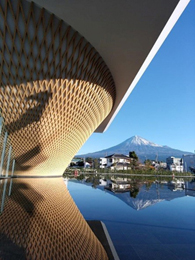 The centre is located near the Fujisan Hongu Sengen Taisha shrine, which worships the sacred mountain and is one of the constituent parts of the world cultural heritage site. The novel design, reminiscent of the inverted image of Mt. Fuji reflected in the water, is the work of the world-famous architect Shigeru Ban. Recently I visited the centre, which has been extremely popular since its opening as a place where you can have fun learning about Mt. Fuji, and here I introduce some of its attractions, especially the permanent exhibition.
The centre is located near the Fujisan Hongu Sengen Taisha shrine, which worships the sacred mountain and is one of the constituent parts of the world cultural heritage site. The novel design, reminiscent of the inverted image of Mt. Fuji reflected in the water, is the work of the world-famous architect Shigeru Ban. Recently I visited the centre, which has been extremely popular since its opening as a place where you can have fun learning about Mt. Fuji, and here I introduce some of its attractions, especially the permanent exhibition.
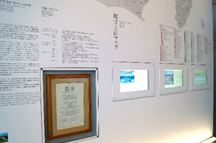 The first floor of the Mt. Fuji World Heritage Centre, Shizuoka consists of the Mt. Fuji Library, which stocks books and reference materials relating to Mt. Fuji and can be used free of charge, and the Café and Museum Shop. On the spacious wall, a map of the Mt. Fuji vicinity shows the location of constituent parts of the world cultural heritage site. Detailed information is available on touch screens in multiple languages. (Basically, information in the centre is displayed in five languages: Japanese, English, Korean, and traditional and simplified Chinese.) There is also a replica of the certificate of Mt. Fuji’s inscription as a UNESCO World Cultural Heritage Site.
The first floor of the Mt. Fuji World Heritage Centre, Shizuoka consists of the Mt. Fuji Library, which stocks books and reference materials relating to Mt. Fuji and can be used free of charge, and the Café and Museum Shop. On the spacious wall, a map of the Mt. Fuji vicinity shows the location of constituent parts of the world cultural heritage site. Detailed information is available on touch screens in multiple languages. (Basically, information in the centre is displayed in five languages: Japanese, English, Korean, and traditional and simplified Chinese.) There is also a replica of the certificate of Mt. Fuji’s inscription as a UNESCO World Cultural Heritage Site.
The permanent exhibition inside the inverted, conical exhibition building is divided into six themes. Below I introduce the characteristics of each section and how to enjoy them.
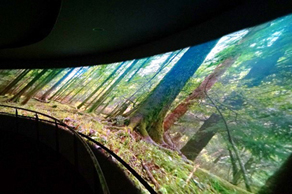 The first section, titled “Ascending Fuji,” consists of a 193 m slope, which is one of the centre’s outstanding features. The loop-shaped slope, which makes use of the inverted, conical-shaped architectural structure, enables visitors to have a simulated experience of actually climbing Mt. Fuji while viewing eye-level images projected on the walls. The images, which change as the climber
The first section, titled “Ascending Fuji,” consists of a 193 m slope, which is one of the centre’s outstanding features. The loop-shaped slope, which makes use of the inverted, conical-shaped architectural structure, enables visitors to have a simulated experience of actually climbing Mt. Fuji while viewing eye-level images projected on the walls. The images, which change as the climber 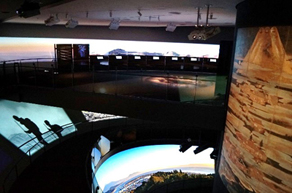 goes higher up the slope, utilize two visual effects. The first is the time-lapse effect. By linking photos taken at certain intervals, changes that occur over a long time can be expressed in just a few minutes. In other words, while going up the 193 m slope, the visitor gets the illusion of actually climbing up Mt. Fuji itself from bottom to top.
goes higher up the slope, utilize two visual effects. The first is the time-lapse effect. By linking photos taken at certain intervals, changes that occur over a long time can be expressed in just a few minutes. In other words, while going up the 193 m slope, the visitor gets the illusion of actually climbing up Mt. Fuji itself from bottom to top.
The second visual effect involves projecting the climber’s silhouette onto background images of the mountain trail, which gives visitors going up the slope a real sense that they are ascending Mt. Fuji. This technique also provides an opportunity to raise awareness of the need to thoroughly prepare for mountain climbing. For example, the image shows climbers putting on raincoats when it starts to rain. The background images shown here were produced by Fuchimu Shimakura, who is well known for having designed the background images for special-effects scenes in Toho’s Godzilla films and other movies.
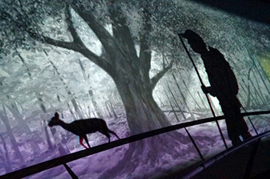
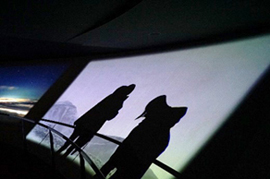
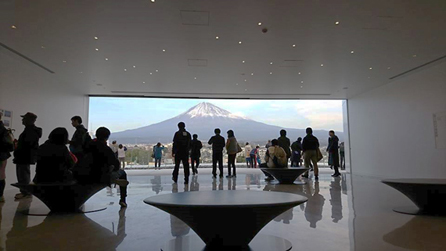 The top of the slope, on the fifth floor of the exhibition building, leads to an observation hall with a fully-opening window, an outdoor terrace, and a splendid view of the towering Mt. Fuji. On a clear day, therefore, visitors can enjoy an unobstructed view of the mountain in all its glory.
The top of the slope, on the fifth floor of the exhibition building, leads to an observation hall with a fully-opening window, an outdoor terrace, and a splendid view of the towering Mt. Fuji. On a clear day, therefore, visitors can enjoy an unobstructed view of the mountain in all its glory.
 After savoring the majestic shape of Mt. Fuji from the observation hall, visitors can proceed to “The Fierce Mountain” zone, where the first thing you will notice is the “Tangible Earth” interactive globe of Professor Shinichi Takemura of the Kyoto University of Art and Design. In an exhibit titled “Mount Fuji and the Planet Earth,” this automatically rotating digital globe and monitor explain the world’s volcanic belts. Other exhibits in this zone include the unaided 3D “Mt. Fuji and the plate tectonics of the Japanese Islands” and “Human history and the formation of Mt. Fuji,” an animated cartoon about the volcanic activity of Mt. Fuji and human history.
After savoring the majestic shape of Mt. Fuji from the observation hall, visitors can proceed to “The Fierce Mountain” zone, where the first thing you will notice is the “Tangible Earth” interactive globe of Professor Shinichi Takemura of the Kyoto University of Art and Design. In an exhibit titled “Mount Fuji and the Planet Earth,” this automatically rotating digital globe and monitor explain the world’s volcanic belts. Other exhibits in this zone include the unaided 3D “Mt. Fuji and the plate tectonics of the Japanese Islands” and “Human history and the formation of Mt. Fuji,” an animated cartoon about the volcanic activity of Mt. Fuji and human history.
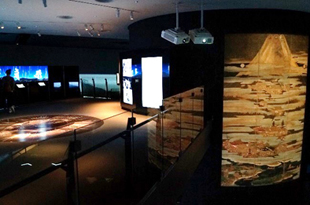 Visitors then descend the slope by which they came up and proceed to the next zone, titled “The Sacred Mountain,” the theme of which is worship of Mt. Fuji. You can see how people have worshiped Mt. Fuji since ancient times in a large replica in the center of the exhibition building of Fuji Mandala (color painting on silk), an important cultural property in the collection of Fujisan Hongu Sengen Taisha. In this zone, visitors can learn about the sacred Mt. Fuji on multilingual touch screens. On the floor in the middle of the zone there is a map of the summit of Mt. Fuji, which enables visitors to easily walk around the eight peaks in Mt. Fuji’s crater, a trek known in Japanese as ohachi meguri (so-called because the crater is shaped like a bowl, or hachi) and an essential part of the mountain pilgrimage.
Visitors then descend the slope by which they came up and proceed to the next zone, titled “The Sacred Mountain,” the theme of which is worship of Mt. Fuji. You can see how people have worshiped Mt. Fuji since ancient times in a large replica in the center of the exhibition building of Fuji Mandala (color painting on silk), an important cultural property in the collection of Fujisan Hongu Sengen Taisha. In this zone, visitors can learn about the sacred Mt. Fuji on multilingual touch screens. On the floor in the middle of the zone there is a map of the summit of Mt. Fuji, which enables visitors to easily walk around the eight peaks in Mt. Fuji’s crater, a trek known in Japanese as ohachi meguri (so-called because the crater is shaped like a bowl, or hachi) and an essential part of the mountain pilgrimage.
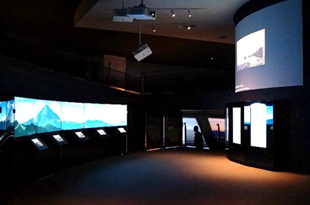 Titled “The Beautiful Mountain,” the fourth zone takes a look at the relationship between Mt. Fuji and art and literature. The touch screens display scrolls depicting pilgrimages to Mt. Fuji and paintings by Hokusai and the Rimpa school, with multilingual commentary on them. Interestingly, an enlargement of the above-mentioned Fuji Mandala painting on the monitor reveals details of pilgrims visiting the Fujisan Hongu Sengen Taisha shrine from the Miho no Matsubara pine grove facing Suruga Bay and then aiming for the summit. With regard to literature, there are references to the works of haiku poet Matsuo Basho and kabuki plays, among others. Personally, I liked the quote from the novel Sanshiro by Natsume Soseki (1867–1916), in which a character says, in criticism of Japanese civilization, “It’s [Mt. Fuji] the finest thing Japan has to offer, the only thing we have to boast about.” *
Titled “The Beautiful Mountain,” the fourth zone takes a look at the relationship between Mt. Fuji and art and literature. The touch screens display scrolls depicting pilgrimages to Mt. Fuji and paintings by Hokusai and the Rimpa school, with multilingual commentary on them. Interestingly, an enlargement of the above-mentioned Fuji Mandala painting on the monitor reveals details of pilgrims visiting the Fujisan Hongu Sengen Taisha shrine from the Miho no Matsubara pine grove facing Suruga Bay and then aiming for the summit. With regard to literature, there are references to the works of haiku poet Matsuo Basho and kabuki plays, among others. Personally, I liked the quote from the novel Sanshiro by Natsume Soseki (1867–1916), in which a character says, in criticism of Japanese civilization, “It’s [Mt. Fuji] the finest thing Japan has to offer, the only thing we have to boast about.” *
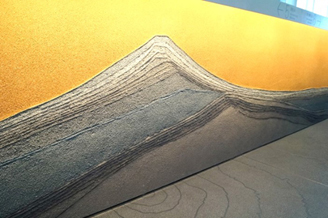 The fifth zone is titled “The Nurturing Mountain.” As soon as I entered this zone, I was startled by the earthen wall depicting the geologic strata of Mt. Fuji. The work of the plaster craftsman Shuhei Hasado, the representative of Shokuninsha Shuhei Gumi who is active both in Japan and overseas, it shows the geologic structure of the mountain, which originally was not one but two volcanoes. The red clay used in the background of the wall pictures, which utilize the natural coloring of soil, exudes a sense of warmth.
The fifth zone is titled “The Nurturing Mountain.” As soon as I entered this zone, I was startled by the earthen wall depicting the geologic strata of Mt. Fuji. The work of the plaster craftsman Shuhei Hasado, the representative of Shokuninsha Shuhei Gumi who is active both in Japan and overseas, it shows the geologic structure of the mountain, which originally was not one but two volcanoes. The red clay used in the background of the wall pictures, which utilize the natural coloring of soil, exudes a sense of warmth.
The rain and snow that falls on Mt. Fuji bubbles up not only through the ground, in places like the Wakutama Pond in the Fujisan Hongu Sengen Taisha shrine, but also at the bottom of Suruga Bay, where it nurtures various forms of life. Visitors can learn on touch screens about the characteristics of living creatures, from alpine areas 2,500 m above sea level to depths of 2,500 m in Suruga Bay.
 Titled “The Inherited Mountain,” the final zone takes up Mt. Fuji as an active volcano and its deep-rooted place in the hearts of Japanese and examines the future of human beings and Mt. Fuji. Mt. Fuji is not only beautiful. Visitors can also check a touch-screen hazard map showing the forecast damage if the volcano ever rumbles and erupts again.
Titled “The Inherited Mountain,” the final zone takes up Mt. Fuji as an active volcano and its deep-rooted place in the hearts of Japanese and examines the future of human beings and Mt. Fuji. Mt. Fuji is not only beautiful. Visitors can also check a touch-screen hazard map showing the forecast damage if the volcano ever rumbles and erupts again.
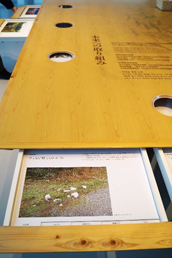 The “Activities and Challenges for the Future” section examines the issues faced by Mt. Fuji, such as the problem of garbage. In this section, the information is given on sheets of paper displayed in table drawers. Visitors who are getting a bit tired of touch screens might find this analog display rather refreshing. Like the latticed wood embracing the exhibition building, the table with the drawers is made of Mt. Fuji cypress.
The “Activities and Challenges for the Future” section examines the issues faced by Mt. Fuji, such as the problem of garbage. In this section, the information is given on sheets of paper displayed in table drawers. Visitors who are getting a bit tired of touch screens might find this analog display rather refreshing. Like the latticed wood embracing the exhibition building, the table with the drawers is made of Mt. Fuji cypress. 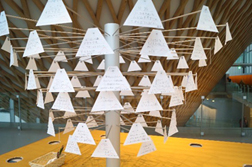 There is also a message corner above this table with lots of sweet messages to Mt. Fuji written by children.
There is also a message corner above this table with lots of sweet messages to Mt. Fuji written by children.
Besides these attractions, another permanent facility at the centre is the 4K video theater with a 265-inch screen. Since the resolution here is four times that of full high definition, the expressions of Mt. Fuji through the four seasons appear with striking beauty—the faint pink cherry blossoms of spring, the scarlet maple leaves of autumn, and the white snow covering the peak in winter. These vivid videos have no accompanying commentary, letting Mt. Fuji’s beauty speak for itself. They are very popular among non-Japanese visitors as well.
Just a quick visit to the Mt. Fuji World Heritage Centre, Shizuoka would be worthwhile, because the building, designed by Shigeru Ban, is a real work of art in itself, and the view of Mt. Fuji from the observation hall is splendid. But a longer visit and leisurely look around the exhibits reveals the deep bonds between the mountain and human beings. So when you visit the centre, I recommend you to take plenty of time and really savor Mt. Fuji as a world cultural heritage.
(*Translation by Jay Rubin, Natsume Soseki, Sanshiro, Penguin Classics, 2009)
Cooperation:
Mt. Fuji World Heritage Centre, Shizuoka
5-12 Miya-cho, Fujinomiya, Shizuoka Prefecture 418-0067
Open: Usually 09:00–17:00 (09:00–18:00 in July and August)
*Final admission is 30 minutes before closing time.
Closed: 3rd Tuesday of every month; facility inspection days; New Year’s holiday
*If the 3rd Tuesday is a national holiday, the centre is open on that day and closed the next.
Tel.: 0544-21-3776; fax: 0544-23-6800
